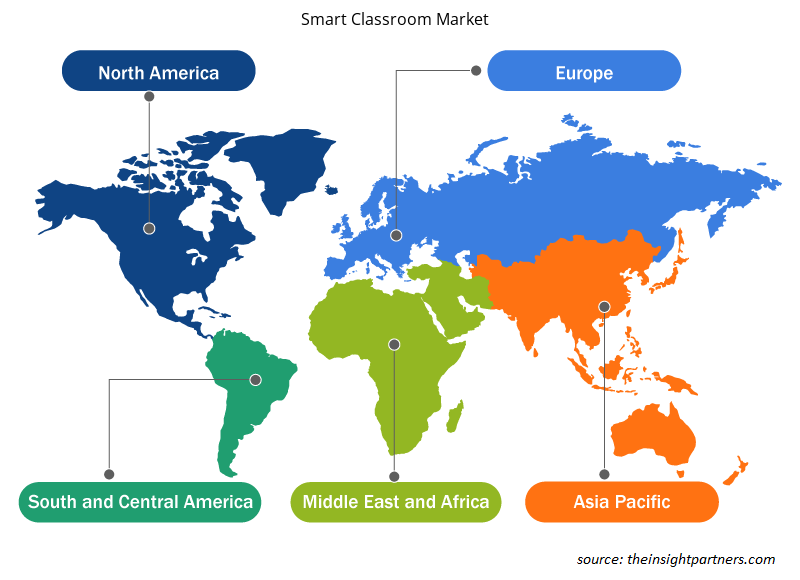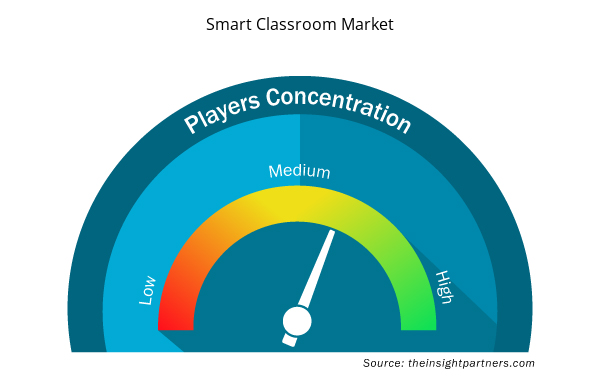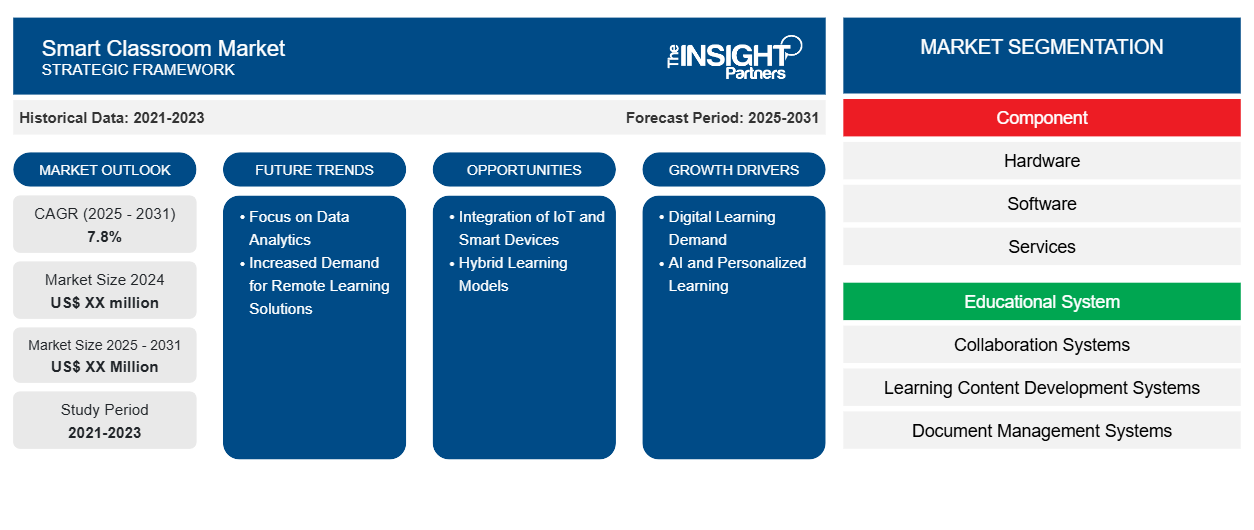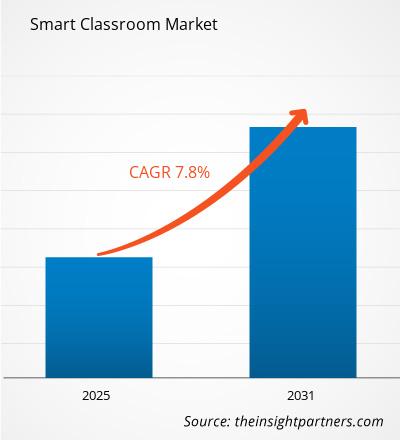Se espera que el mercado de aulas inteligentes registre una CAGR del 7,8 % entre 2024 y 2031, y que el tamaño del mercado se expanda de XX millones de dólares estadounidenses en 2024 a XX millones de dólares estadounidenses en 2031.CAGR of 7.8% from 2024 to 2031, with a market size expanding from US$ XX million in 2024 to US$ XX Million by 2031.
El informe está segmentado por componente (hardware, software, servicios), sistema educativo (sistemas de colaboración, sistemas de desarrollo de contenido de aprendizaje, sistemas de gestión de documentos, sistemas de respuesta de estudiantes, sistemas de gestión de aprendizaje, sistemas de creación de contenido, sistemas de gestión de aulas, otros), aplicación (juegos educativos, seguridad educativa, ERP educativo), uso final (jardín de infantes, educación primaria y secundaria, educación superior). El análisis global se desglosa aún más a nivel regional y por países principales. El informe ofrece el valor en USD para el análisis y los segmentos anteriores.ERP), End Use (Kindergarten, K-12 , Higher Education). The global analysis is further broken-down at regional level and major countries. The Report Offers the Value in USD for the above analysis and segments.
Propósito del Informe
El informe Smart Classroom Market de The Insight Partners tiene como objetivo describir el panorama actual y el crecimiento futuro, los principales factores impulsores, los desafíos y las oportunidades. Esto proporcionará información a diversas partes interesadas del negocio, como:
- Proveedores/fabricantes de tecnología: Para comprender la dinámica cambiante del mercado y conocer las oportunidades potenciales de crecimiento, lo que les permitirá tomar decisiones estratégicas informadas.
- Inversionistas: Realizar un análisis exhaustivo de tendencias sobre la tasa de crecimiento del mercado, las proyecciones financieras del mercado y las oportunidades que existen en toda la cadena de valor.
- Órganos reguladores: Regular las políticas y vigilar las actividades del mercado con el objetivo de minimizar los abusos, preservar la confianza de los inversores y defender la integridad y la estabilidad del mercado.
Segmentación del mercado de aulas inteligentes
Componente
- Hardware
- Software
- Servicios
Sistema Educativo
- Sistemas de colaboración
- Sistemas de desarrollo de contenidos de aprendizaje
- Sistemas de gestión documental
- Sistemas de respuesta de los estudiantes
- Sistemas de gestión del aprendizaje
- Sistemas de creación de contenidos
- Sistemas de gestión de aulas
- Otros
Solicitud
- Juegos educativos
- Seguridad Educativa
- ERP educativo
Uso final
- Kindergarten
- K-12
- Educación superior
Personalice este informe según sus necesidades
Obtendrá personalización en cualquier informe, sin cargo, incluidas partes de este informe o análisis a nivel de país, paquete de datos de Excel, así como también grandes ofertas y descuentos para empresas emergentes y universidades.
- Obtenga las principales tendencias clave del mercado de este informe.Esta muestra GRATUITA incluirá análisis de datos, desde tendencias del mercado hasta estimaciones y pronósticos.
Factores impulsores del crecimiento del mercado de aulas inteligentes
- Demanda de aprendizaje digital: Una tendencia cada vez mayor que conduce al surgimiento del mercado de aulas inteligentes se puede atribuir a la forma en que se aplican las soluciones digitales en el aprendizaje. A medida que los estudiantes, las escuelas y las universidades buscan una forma de aprendizaje completamente diferente, flexible y accesible, las instituciones educativas están mostrando su voluntad de adoptar tecnologías inteligentes para que el aprendizaje sea atractivo. Ya no se trata simplemente de reemplazar los viejos métodos por nuevas plataformas, sino, de hecho, de una reorientación total de lo que significan el aprendizaje y la enseñanza. Los cursos en línea y los enfoques de aprendizaje combinado se convierten en la norma, y las escuelas y universidades aumentan la necesidad de invertir en tecnologías de vanguardia que ayuden a que este aprendizaje sea interactivo y atractivo.
- Inteligencia artificial y aprendizaje personalizado: las herramientas basadas en inteligencia artificial han transformado la práctica educativa al introducir vías de aprendizaje individualizadas que responden a las necesidades de los distintos estudiantes. Por ejemplo, mediante el uso de análisis de datos, estas tecnologías pueden analizar el rendimiento y las preferencias de los estudiantes para lograr una enseñanza personalizada y una asignación de recursos eficaces. Con estas medidas, el aprendizaje se vuelve más atractivo y relevante para aumentar la motivación y mejorar los resultados académicos de los estudiantes en cuestión. Este tipo de adaptación sobre la marcha de los recursos y métodos de aprendizaje no solo inculca una comprensión más profunda del tema, sino que también permite a los estudiantes convertirse en maestros de su proceso de aprendizaje. En este contexto, las soluciones basadas en inteligencia artificial están ganando cada vez más popularidad en los entornos educativos contemporáneos porque se adaptan mejor a las expectativas, que cambian dinámicamente, de los profesores y los alumnos por igual en un mundo digital.
Tendencias futuras del mercado de aulas inteligentes
- Centrarse en el análisis de datos: se espera que el análisis de datos sea un área en la que la educación experimente un crecimiento significativo a medida que comience a transformar la forma en que los educadores enseñan y aprenden. Los educadores pueden analizar en profundidad cuestiones relacionadas con el rendimiento, la participación y los patrones de aprendizaje de los estudiantes mediante el análisis de datos, lo que permite una comprensión más significativa de cómo aprenden los estudiantes individuales y enfrentan los desafíos del aprendizaje. Con la posibilidad de analizar métricas tan variadas como la asistencia y la participación y las tasas de finalización de las tareas, los educadores pueden realmente comenzar a identificar tendencias e intervenir antes de que los estudiantes estén realmente en problemas: hará que las estrategias de enseñanza funcionen mejor y, al mismo tiempo, permitirá una experiencia educativa más personalizada para esos estudiantes, lo que aumentará los resultados de los estudiantes y también su compromiso con el material de aprendizaje.
- Mayor demanda de soluciones de aprendizaje a distancia: el auge de los modelos de aprendizaje remoto e híbrido ha impulsado la demanda de tecnologías de aulas inteligentes que faciliten la educación en línea. Las herramientas que respaldan la colaboración virtual, las lecciones interactivas y la retroalimentación en tiempo real se están volviendo esenciales tanto para los educadores como para los estudiantes. Esta tendencia resalta la necesidad de entornos de aprendizaje flexibles que puedan adaptarse a los cambiantes panoramas educativos.
Oportunidades de mercado para las aulas inteligentes
- Integración de IoT y dispositivos inteligentes: Esta integración permite la implementación completa de la interactividad y la conectividad en el aula y la convierte en un lugar de aprendizaje interesante para los estudiantes. El uso de sensores y conectividad en las herramientas cotidianas del aula ha brindado a los educadores oportunidades para desarrollar la comunicación en tiempo real y el intercambio de datos entre dispositivos, una configuración que fomenta el trabajo en equipo y la participación activa de los estudiantes. Esto no solo enriquece la experiencia educativa, sino que también promueve positivamente la adopción de tecnologías de aulas inteligentes, ya que las instituciones se vuelven más conscientes de la importancia de los ecosistemas de aprendizaje conectados.
- Modelos de aprendizaje híbridos: los modelos de aprendizaje híbridos están revolucionando actualmente el panorama escolar a través de modalidades de enseñanza mixtas, presenciales y en línea. Se convierten en una plataforma que proporciona una experiencia de aprendizaje versátil que se adapta a las diversas necesidades y requisitos de los estudiantes. De este modo, se pueden adaptar diferentes estilos y preferencias de aprendizaje. A medida que el entorno educativo continúa evolucionando, se espera que la necesidad de modelos híbridos se mantenga, satisfaciendo las necesidades cambiantes de los estudiantes y del entorno educativo en general. Esto incluye la integración de IoT dentro de los modelos de aprendizaje híbridos para un sistema educativo más receptivo.
Perspectivas regionales del mercado de aulas inteligentes
Los analistas de Insight Partners explicaron en detalle las tendencias y los factores regionales que influyen en el mercado de aulas inteligentes durante el período de pronóstico. Esta sección también analiza los segmentos y la geografía del mercado de aulas inteligentes en América del Norte, Europa, Asia Pacífico, Oriente Medio y África, y América del Sur y Central.

- Obtenga datos regionales específicos para el mercado de aulas inteligentes
Alcance del informe de mercado de aulas inteligentes
| Atributo del informe | Detalles |
|---|---|
| Tamaño del mercado en 2024 | XX millones de dólares estadounidenses |
| Tamaño del mercado en 2031 | US$ XX millones |
| Tasa de crecimiento anual compuesta (CAGR) global (2025-2031) | 7,8% |
| Datos históricos | 2021-2023 |
| Período de pronóstico | 2025-2031 |
| Segmentos cubiertos | Por componente
|
| Regiones y países cubiertos | América del norte
|
| Líderes del mercado y perfiles de empresas clave |
|
Densidad de actores del mercado de aulas inteligentes: comprensión de su impacto en la dinámica empresarial
El mercado de aulas inteligentes está creciendo rápidamente, impulsado por la creciente demanda de los usuarios finales debido a factores como la evolución de las preferencias de los consumidores, los avances tecnológicos y una mayor conciencia de los beneficios del producto. A medida que aumenta la demanda, las empresas amplían sus ofertas, innovan para satisfacer las necesidades de los consumidores y aprovechan las tendencias emergentes, lo que impulsa aún más el crecimiento del mercado.
La densidad de actores del mercado se refiere a la distribución de las empresas o firmas que operan dentro de un mercado o industria en particular. Indica cuántos competidores (actores del mercado) están presentes en un espacio de mercado determinado en relación con su tamaño o valor total de mercado.
Las principales empresas que operan en el mercado de aulas inteligentes son:
- Fujitsu
- Soluciones Educomp Ltd.
- HCL Learning Limitada
- Compañía de desarrollo HP, LP
- Jenzabar, Inc.
Descargo de responsabilidad : Las empresas enumeradas anteriormente no están clasificadas en ningún orden particular.

- Obtenga una descripción general de los principales actores clave del mercado de aulas inteligentes
Puntos de venta clave
- Cobertura integral: el informe cubre de manera integral el análisis de productos, servicios, tipos y usuarios finales del mercado de aulas inteligentes, proporcionando un panorama holístico.
- Análisis de expertos: el informe se compila sobre la base de un profundo conocimiento de expertos y analistas de la industria.
- Información actualizada: El informe asegura relevancia comercial debido a su cobertura de información reciente y tendencias de datos.
- Opciones de personalización: este informe se puede personalizar para satisfacer los requisitos específicos del cliente y adaptarse adecuadamente a las estrategias comerciales.
Por lo tanto, el informe de investigación sobre el mercado de aulas inteligentes puede ayudar a abrir camino para descifrar y comprender el escenario de la industria y las perspectivas de crecimiento. Si bien puede haber algunas preocupaciones válidas, los beneficios generales de este informe tienden a superar las desventajas.
- Análisis histórico (2 años), año base, pronóstico (7 años) con CAGR
- Análisis PEST y FODA
- Tamaño del mercado Valor/volumen: global, regional, nacional
- Industria y panorama competitivo
- Conjunto de datos de Excel



Report Coverage
Revenue forecast, Company Analysis, Industry landscape, Growth factors, and Trends

Segment Covered
This text is related
to segments covered.

Regional Scope
North America, Europe, Asia Pacific, Middle East & Africa, South & Central America

Country Scope
This text is related
to country scope.
Preguntas frecuentes
Some of the customization options available based on the request are an additional 3-5 company profiles and country-specific analysis of 3-5 countries of your choice. Customizations are to be requested/discussed before making final order confirmation as our team would review the same and check the feasibility
The report can be delivered in PDF/PPT format; we can also share excel dataset based on the request
Focus on Data Analytics is anticipated to play a significant role in the global smart classroom market in the coming years
The major factors driving the smart classroom market are:
1. Digital Learning Demand
2. AI and Personalized Learning
The Smart Classroom Market is estimated to witness a CAGR of 7.8% from 2023 to 2031
-
Trends and growth analysis reports related to Electronics and Semiconductor : READ MORE..
1. FUJITSU
2. Educomp Solutions Ltd
3. HCL Learning Limited
4. HP Development Company, L.P.
5. Jenzabar, Inc.
6. Lenovo
7. Microsoft
8. Pearson India Education Services Pvt. Ltd
9. SAMSUNG
10. Smart Technologies
The Insight Partners performs research in 4 major stages: Data Collection & Secondary Research, Primary Research, Data Analysis and Data Triangulation & Final Review.
- Data Collection and Secondary Research:
As a market research and consulting firm operating from a decade, we have published and advised several client across the globe. First step for any study will start with an assessment of currently available data and insights from existing reports. Further, historical and current market information is collected from Investor Presentations, Annual Reports, SEC Filings, etc., and other information related to company’s performance and market positioning are gathered from Paid Databases (Factiva, Hoovers, and Reuters) and various other publications available in public domain.
Several associations trade associates, technical forums, institutes, societies and organization are accessed to gain technical as well as market related insights through their publications such as research papers, blogs and press releases related to the studies are referred to get cues about the market. Further, white papers, journals, magazines, and other news articles published in last 3 years are scrutinized and analyzed to understand the current market trends.
- Primary Research:
The primarily interview analysis comprise of data obtained from industry participants interview and answers to survey questions gathered by in-house primary team.
For primary research, interviews are conducted with industry experts/CEOs/Marketing Managers/VPs/Subject Matter Experts from both demand and supply side to get a 360-degree view of the market. The primary team conducts several interviews based on the complexity of the markets to understand the various market trends and dynamics which makes research more credible and precise.
A typical research interview fulfils the following functions:
- Provides first-hand information on the market size, market trends, growth trends, competitive landscape, and outlook
- Validates and strengthens in-house secondary research findings
- Develops the analysis team’s expertise and market understanding
Primary research involves email interactions and telephone interviews for each market, category, segment, and sub-segment across geographies. The participants who typically take part in such a process include, but are not limited to:
- Industry participants: VPs, business development managers, market intelligence managers and national sales managers
- Outside experts: Valuation experts, research analysts and key opinion leaders specializing in the electronics and semiconductor industry.
Below is the breakup of our primary respondents by company, designation, and region:

Once we receive the confirmation from primary research sources or primary respondents, we finalize the base year market estimation and forecast the data as per the macroeconomic and microeconomic factors assessed during data collection.
- Data Analysis:
Once data is validated through both secondary as well as primary respondents, we finalize the market estimations by hypothesis formulation and factor analysis at regional and country level.
- Macro-Economic Factor Analysis:
We analyse macroeconomic indicators such the gross domestic product (GDP), increase in the demand for goods and services across industries, technological advancement, regional economic growth, governmental policies, the influence of COVID-19, PEST analysis, and other aspects. This analysis aids in setting benchmarks for various nations/regions and approximating market splits. Additionally, the general trend of the aforementioned components aid in determining the market's development possibilities.
- Country Level Data:
Various factors that are especially aligned to the country are taken into account to determine the market size for a certain area and country, including the presence of vendors, such as headquarters and offices, the country's GDP, demand patterns, and industry growth. To comprehend the market dynamics for the nation, a number of growth variables, inhibitors, application areas, and current market trends are researched. The aforementioned elements aid in determining the country's overall market's growth potential.
- Company Profile:
The “Table of Contents” is formulated by listing and analyzing more than 25 - 30 companies operating in the market ecosystem across geographies. However, we profile only 10 companies as a standard practice in our syndicate reports. These 10 companies comprise leading, emerging, and regional players. Nonetheless, our analysis is not restricted to the 10 listed companies, we also analyze other companies present in the market to develop a holistic view and understand the prevailing trends. The “Company Profiles” section in the report covers key facts, business description, products & services, financial information, SWOT analysis, and key developments. The financial information presented is extracted from the annual reports and official documents of the publicly listed companies. Upon collecting the information for the sections of respective companies, we verify them via various primary sources and then compile the data in respective company profiles. The company level information helps us in deriving the base number as well as in forecasting the market size.
- Developing Base Number:
Aggregation of sales statistics (2020-2022) and macro-economic factor, and other secondary and primary research insights are utilized to arrive at base number and related market shares for 2022. The data gaps are identified in this step and relevant market data is analyzed, collected from paid primary interviews or databases. On finalizing the base year market size, forecasts are developed on the basis of macro-economic, industry and market growth factors and company level analysis.
- Data Triangulation and Final Review:
The market findings and base year market size calculations are validated from supply as well as demand side. Demand side validations are based on macro-economic factor analysis and benchmarks for respective regions and countries. In case of supply side validations, revenues of major companies are estimated (in case not available) based on industry benchmark, approximate number of employees, product portfolio, and primary interviews revenues are gathered. Further revenue from target product/service segment is assessed to avoid overshooting of market statistics. In case of heavy deviations between supply and demand side values, all thes steps are repeated to achieve synchronization.
We follow an iterative model, wherein we share our research findings with Subject Matter Experts (SME’s) and Key Opinion Leaders (KOLs) until consensus view of the market is not formulated – this model negates any drastic deviation in the opinions of experts. Only validated and universally acceptable research findings are quoted in our reports.
We have important check points that we use to validate our research findings – which we call – data triangulation, where we validate the information, we generate from secondary sources with primary interviews and then we re-validate with our internal data bases and Subject matter experts. This comprehensive model enables us to deliver high quality, reliable data in shortest possible time.


 Obtenga una muestra gratuita de este informe
Obtenga una muestra gratuita de este informe